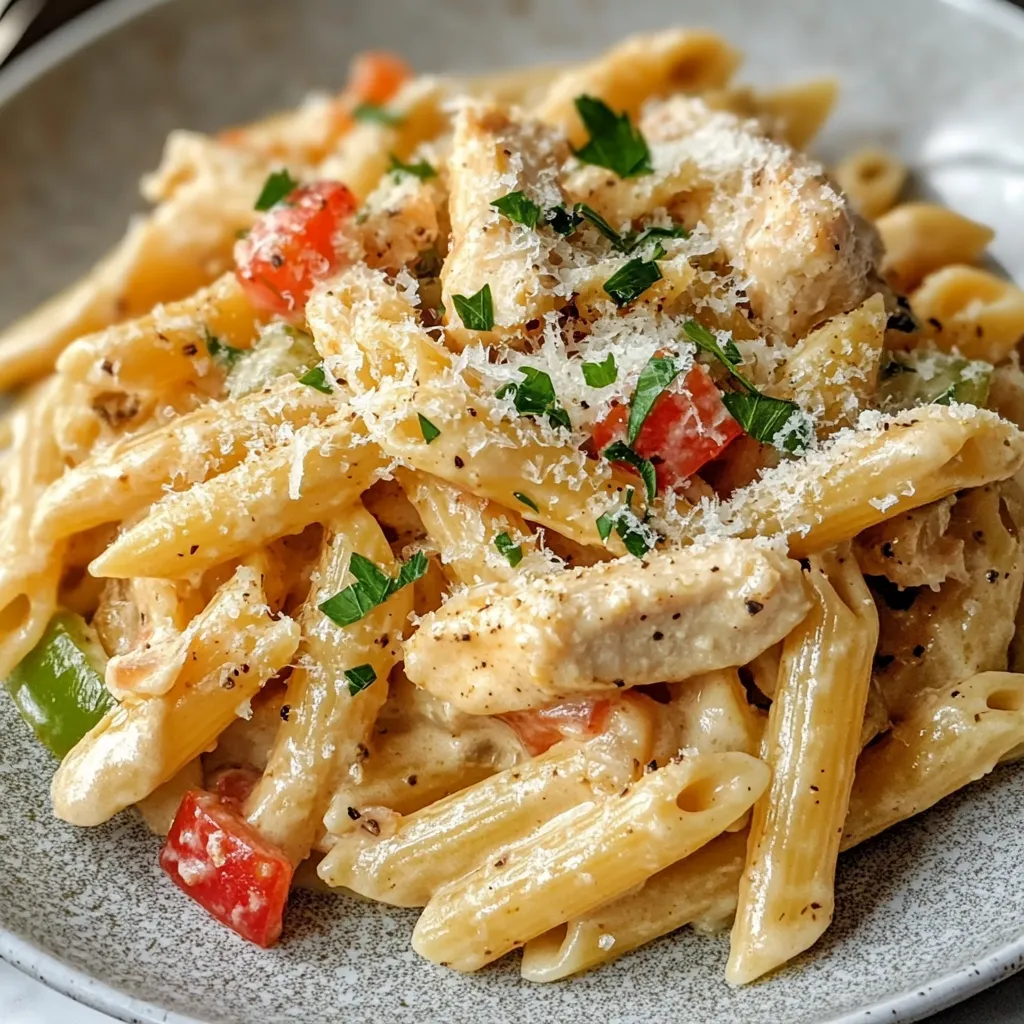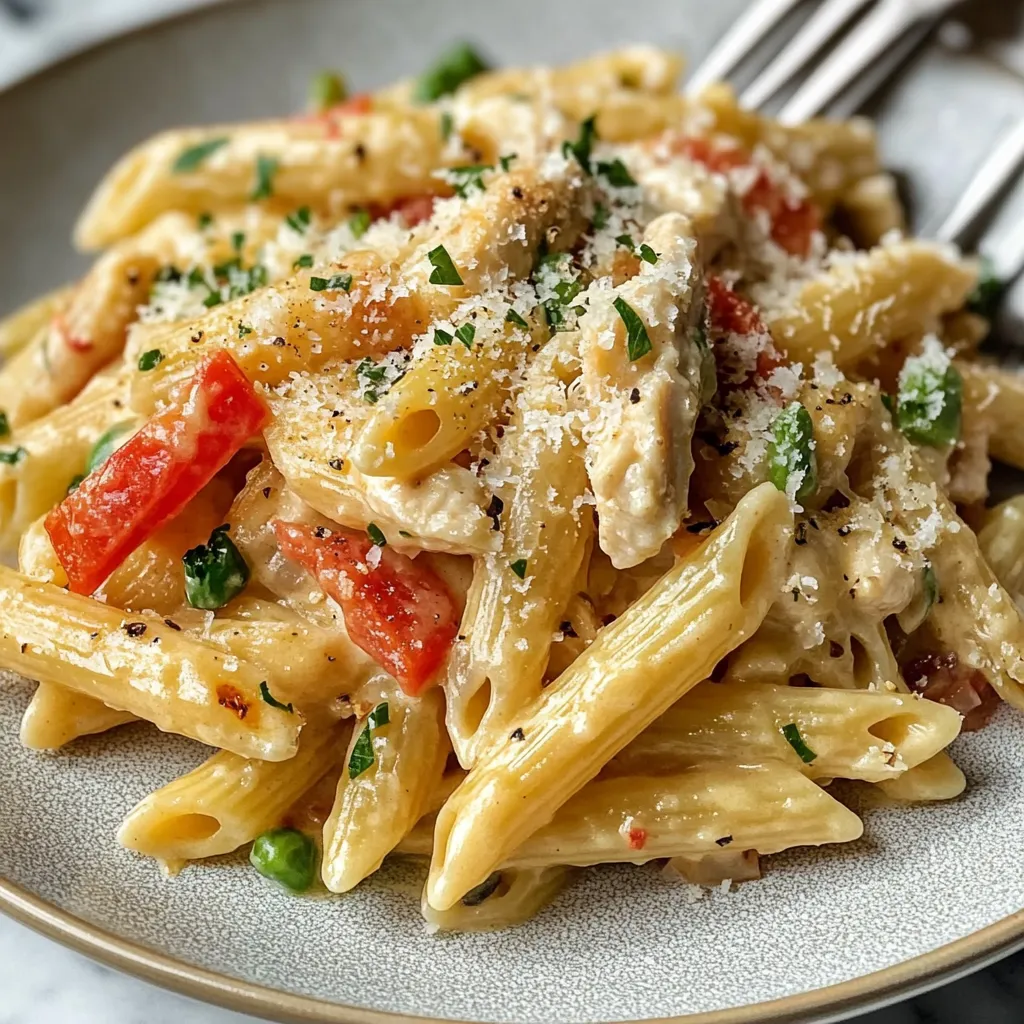 Save
Save
Creamy, spicy sauce envelops tender pasta and Cajun-seasoned chicken in this bold dish that delivers restaurant-quality flavor with surprising simplicity. The zesty kick from jalapeños creates the 'rattlesnake' bite that gives this pasta its memorable name, while colorful bell peppers add sweetness that perfectly balances the heat. This satisfying one-pot wonder transforms everyday ingredients into something extraordinary that tastes like you spent hours in the kitchen rather than minutes.
Last month when unexpected guests dropped by, I quickly assembled this pasta with ingredients I had on hand. The looks of delight around the table as everyone took their first bite made it seem like I'd planned an elaborate dinner rather than a last-minute solution. Something about the combination of creamy sauce with spicy elements seems to create universal appeal—even my spice-averse father-in-law cleaned his plate.
Essential Components
- Penne Pasta: Creates the substantial foundation with perfect sauce-capturing ridges. The tubular shape holds pockets of creamy sauce for flavor in every bite.
- Chicken Breast: Provides lean protein that readily absorbs the Cajun seasoning. Slicing into uniform pieces ensures even, quick cooking throughout.
- Cajun Seasoning: Delivers authentic Louisiana flavor with minimal effort. This spice blend typically includes paprika, garlic, pepper, and herbs for immediate depth.
- Bell Peppers: Contribute vibrant color and sweet contrast to the spice. Using both red and green varieties creates visual appeal alongside flavor variation.
- Jalapeño Peppers: Supply the essential heat that gives the dish its 'rattlesnake' name. Controlling the seeds and membranes allows precise heat adjustment.
- Red Onion: Adds aromatic foundation and subtle sweetness when cooked. The purple-red color provides additional visual interest throughout the finished dish.
- Butter and Flour: Work together to create the silky roux that thickens the sauce. This traditional technique ensures perfect sauce consistency without separating.
- Milk or Half-and-Half: Forms the creamy base that coats each component. Higher fat content creates richer results, though lighter options work acceptably.
- Parmesan Cheese: Contributes savory depth and slight saltiness throughout. Freshly grated melts more smoothly than pre-packaged varieties.
Preparation Method
- Pasta Cooking:
- Bring a large pot of generously salted water to a rolling boil over high heat. Add penne pasta and cook until just shy of al dente, about 9-10 minutes or 1-2 minutes less than package directions. This slight undercooking ensures the pasta will finish perfectly when tossed with the hot sauce rather than becoming mushy. Drain without rinsing to preserve the starchy exterior that helps sauce adhesion.
- Chicken Preparation:
- While pasta cooks, slice chicken breasts into bite-sized pieces of uniform thickness, then toss thoroughly with Cajun seasoning until evenly coated. The uniform size ensures quick, even cooking, while pre-seasoning allows the flavors to begin developing before hitting the pan.
- Chicken Cooking:
- Heat olive oil in a large, deep skillet over medium-high heat until shimmering but not smoking. Add seasoned chicken pieces in a single layer without overcrowding, working in batches if necessary. Cook undisturbed for 2-3 minutes to develop proper browning before stirring. Continue cooking until golden on all sides and just cooked through, about 5-7 minutes total. Transfer to a clean plate to prevent overcooking.
- Vegetable Sautéing:
- Add a touch more olive oil to the same skillet if needed, then add diced bell peppers, red onion, and jalapeños. Sauté over medium-high heat, stirring occasionally, until vegetables soften slightly while maintaining some crispness, about 4-5 minutes. Add minced garlic during the final minute of cooking to prevent burning while still developing aromatic flavors.
- Sauce Creation:
- Reduce heat to medium before adding butter to the skillet, allowing it to melt completely. Sprinkle flour over the vegetables, stirring constantly for 1-2 minutes to cook out the raw flour taste while coating everything evenly. This careful cooking creates a roux that thickens the sauce without lumps or graininess.
- Liquid Integration:
- Gradually pour milk or half-and-half into the skillet while whisking constantly to prevent lumps from forming. This slow addition creates a smooth, velvety sauce without flour pockets. Bring to a gentle simmer, allowing the sauce to thicken until it coats the back of a spoon, about 2-3 minutes.
- Cheese Incorporation:
- Reduce heat to low before stirring in freshly grated Parmesan cheese, allowing it to melt completely into the sauce without becoming stringy or separating. The residual heat melts the cheese perfectly while the reduced temperature prevents the sauce from breaking.
- Final Assembly:
- Return cooked chicken to the skillet along with any accumulated juices. Add drained pasta, tossing gently but thoroughly to ensure even coating of sauce on all components. If sauce seems too thick, add small amounts of reserved pasta water to achieve desired consistency. The starch in this water helps maintain the sauce's silky texture.
 Save
Save
My first attempt at this recipe taught me an important lesson about heat levels. I left all the seeds and membranes in the jalapeños, creating a dish that was deliciously flavorful but almost too spicy to enjoy comfortably. Now I remove about half the seeds and membranes, which creates the perfect warming heat that gives the dish character without overwhelming the other flavors. This small adjustment transformed it from a challenge to eat into a craveworthy favorite.
Serving Suggestions
This hearty pasta creates beautiful harmony with simple sides that complement without competing. Serve alongside a crisp garden salad dressed with light vinaigrette to cut through the richness of the creamy sauce. Crusty bread offers the perfect vehicle for capturing any remaining sauce on the plate. For a complete Southern-inspired meal, add cornbread with honey butter that provides sweet contrast to the dish's spicy elements.
Creative Variations
This adaptable recipe welcomes numerous interpretations while maintaining its essential character. For seafood lovers, substitute shrimp or crawfish for the chicken, reducing cooking time accordingly. Sausage enthusiasts might incorporate sliced andouille for authentic Cajun flavor and additional spice. For extra vegetable content, add sautéed mushrooms or wilted spinach during the final assembly for nutrition and textural contrast.
Keeping It Fresh
Store leftover pasta in airtight containers in the refrigerator for up to four days, maintaining both flavor and food safety. When reheating, add a splash of milk to restore the creamy consistency, as the pasta will have absorbed much of the sauce during storage. Warm gently over medium-low heat or in short microwave intervals, stirring frequently to prevent overheating, which can cause the sauce to separate.
 Save
Save
After preparing this rattlesnake pasta countless times for family dinners and casual entertaining, I've found it represents the perfect balance between impressive flavor and practical preparation. The combination of spicy elements with creamy comfort creates a dish that satisfies deeply while fitting easily into busy weeknight schedules. Whether served for everyday family meals or casual gatherings with friends, this pasta consistently delivers both excitement and satisfaction in every bite.
Common Questions About Cooking
- → Why is it called 'Rattlesnake Pasta'?
- The name 'Rattlesnake Pasta' comes from the spicy kick of the dish, reminiscent of a rattlesnake's bite! The jalapeños provide the heat, while the colorful bell peppers somewhat resemble a snake's patterned skin. It's not made with actual rattlesnake meat - it's just a playful name for this spicy, bold pasta dish that originated in American casual dining restaurants.
- → How can I adjust the spice level?
- This dish is customizable to your preferred spice level. For milder heat, remove all seeds and membranes from the jalapeños, use fewer jalapeños, or substitute with poblano peppers which are less spicy. For more heat, keep the seeds and membranes in the jalapeños, add more of them, or include a diced serrano or habanero pepper. You can also adjust the amount of Cajun seasoning or add a dash of hot sauce to the finished dish.
- → Can I make a vegetarian version of this pasta?
- Yes! To make a vegetarian Rattlesnake Pasta, simply omit the chicken and add more vegetables. Zucchini, yellow squash, mushrooms, or broccoli would work well. You could also add a plant-based protein like sautéed firm tofu or tempeh seasoned with the same Cajun spices. Make sure your Parmesan cheese is vegetarian (made with microbial rennet instead of animal rennet), or substitute with a vegetarian alternative.
- → What can I serve with Rattlesnake Pasta?
- This hearty pasta dish is a complete meal on its own, but it pairs nicely with a simple side salad dressed with vinaigrette to balance the richness. Garlic bread or a crusty baguette is perfect for soaking up any extra sauce. For a lighter option, serve with steamed or roasted vegetables like asparagus or broccoli. A glass of crisp white wine like Sauvignon Blanc or Pinot Grigio complements the flavors well.
- → Can I make this dish ahead of time?
- While this pasta is best enjoyed fresh, you can prepare components ahead of time. Cook the chicken and vegetables and store them separately in the refrigerator. The sauce is best made fresh, but you can also prepare the pasta ahead and toss it with a bit of olive oil to prevent sticking. When ready to serve, reheat the chicken and vegetables, make the sauce, and combine with the pasta. If storing leftovers, the pasta may absorb some of the sauce, so you might need to add a splash of milk when reheating.
